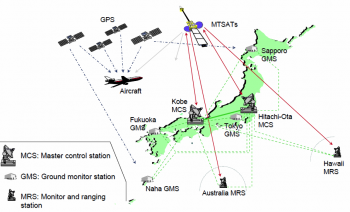If you wish to contribute or participate in the discussions about articles you are invited to contact the Editor
MSAS Architecture: Difference between revisions
m (removed broken link.) |
m (fixed broken link.) |
||
| Line 8: | Line 8: | ||
The MTSAT Satellite Augmentation System ([[MSAS General Introduction|MSAS]]) is the Japanese [[SBAS General Introduction|Satellite Based Augmentation System (SBAS)]] System:<ref name="MSAS_STATUS_2007">[http://www.oosa.unvienna.org/pdf/icg/2007/icg2/presentations/04_01.pdf MSAS Current Status, Japan Civil Aviation Bureau,] [http://www.oosa.unvienna.org/oosa/SAP/gnss/icg/icg02/presentations.html Second Meeting of the International Committee on Global Navigation Satellite Systems (ICG) organized by the International Space Research Organization, Bangalore, India , 5 - 7 September 2007]</ref> a GPS Augmentation system with the goal of improving its accuracy, integrity, and availability, and that uses the Multifunctional Transport Satellites (MTSAT) owned and operated by the [http://www.mlit.go.jp Japanese Ministry of Land, Infrastructure and Transport] and the [http://www.jma.go.jp Japan Meteorological Agency (JMA).]<ref name=MTSAS_WIKI_1>[http://en.wikipedia.org/wiki/Multi-Functional_Transport_Satellite Multi-Functional Transport Satellite] in [http://en.wikipedia.org/ Wikipedia]</ref> | The MTSAT Satellite Augmentation System ([[MSAS General Introduction|MSAS]]) is the Japanese [[SBAS General Introduction|Satellite Based Augmentation System (SBAS)]] System:<ref name="MSAS_STATUS_2007">[http://www.oosa.unvienna.org/pdf/icg/2007/icg2/presentations/04_01.pdf MSAS Current Status, Japan Civil Aviation Bureau,] [http://www.oosa.unvienna.org/oosa/SAP/gnss/icg/icg02/presentations.html Second Meeting of the International Committee on Global Navigation Satellite Systems (ICG) organized by the International Space Research Organization, Bangalore, India , 5 - 7 September 2007]</ref> a GPS Augmentation system with the goal of improving its accuracy, integrity, and availability, and that uses the Multifunctional Transport Satellites (MTSAT) owned and operated by the [http://www.mlit.go.jp Japanese Ministry of Land, Infrastructure and Transport] and the [http://www.jma.go.jp Japan Meteorological Agency (JMA).]<ref name=MTSAS_WIKI_1>[http://en.wikipedia.org/wiki/Multi-Functional_Transport_Satellite Multi-Functional Transport Satellite] in [http://en.wikipedia.org/ Wikipedia]</ref> | ||
First tests were accomplished successfully, and MSAS system for aviation use was declared operational in September 27, 2007,<ref name="MSAS_STATUS_2007_2">QZSS / MSAS Status, CGSIC –47th Meeting ,Fort Worth, Texas September25, 2007, Satoshi KOGURE, [http://www.jaxa.jp/index_e.html Japan Aerospace Exploration Agency,] QZSS Project Team</ref><ref name="MSAS_GPSW">[http://www.gpsworld.com/ | First tests were accomplished successfully, and MSAS system for aviation use was declared operational in September 27, 2007,<ref name="MSAS_STATUS_2007_2">QZSS / MSAS Status, CGSIC –47th Meeting ,Fort Worth, Texas September25, 2007, Satoshi KOGURE, [http://www.jaxa.jp/index_e.html Japan Aerospace Exploration Agency,] QZSS Project Team</ref><ref name="MSAS_GPSW">[http://www.gpsworld.com/surveyperspectives-late-april-2008-7289 Eric Gakstatter, Perspectives - Late April 2008, GPSworld, April 15, 2008]</ref><ref name=MSAS_WIKI_2>[http://en.wikipedia.org/wiki/Multi-functional_Satellite_Augmentation_System Multi-functional Satellite Augmentation System] in [http://en.wikipedia.org/ Wikipedia]</ref> providing a service of horizontal guidance for En-route through Non-Precision Approach.<ref name="MSAS_STATUS_2007"/><ref name="MSAS_STATUS_2007_2"/><ref name="MSAS_STATUS_2008">[http://www.oosa.unvienna.org/pdf/icg/2008/icg3/08-1.pdf Overview of MSAS, Presentation for ICG-3, 2008]</ref> | ||
Revision as of 16:22, 8 September 2014
| MSAS | |
|---|---|
| Title | MSAS Architecture |
| Edited by | GMV |
| Level | Basic |
| Year of Publication | 2011 |
The MTSAT Satellite Augmentation System (MSAS) is the Japanese Satellite Based Augmentation System (SBAS) System:[1] a GPS Augmentation system with the goal of improving its accuracy, integrity, and availability, and that uses the Multifunctional Transport Satellites (MTSAT) owned and operated by the Japanese Ministry of Land, Infrastructure and Transport and the Japan Meteorological Agency (JMA).[2]
First tests were accomplished successfully, and MSAS system for aviation use was declared operational in September 27, 2007,[3][4][5] providing a service of horizontal guidance for En-route through Non-Precision Approach.[1][3][6]
MSAS Architecture
MSAS works by processing GPS data collected by a network of reference stations to generate the SBAS message which is uploaded to the GEO satellites. The GEO satellites broadcast this information to the user receivers, which compute the aircraft positioning and inform on potential alert messages.[6]
The main layers of MSAS architecture are:[6]
- MSAS Ground Segment: The ground segment is composed of four Ground Monitor Station (GMS) that collect information on the GPS and MTSAT signals. Then, the GMS send their data to two Master Control Station (MCS) in Kobe and Hitachiota, that compute precise differential corrections and integrity bounds and send them to the MTSAT satellites for rebroadcast to the User Segment. The MSAS Ground Segment is completed with two Monitor and Ranging Station (MRS), whose purpose is primarily the correct orbit determination of the MTSAT satellites.
- MSAS Space Segment: The space segment consists of two geosynchronous satellites (GEO): the Multifunctional Transport Satellites (MTSAT). These satellites are used also for meteorological purposes. Their navigation payloads are in charge of broadcasting the correction messages generated by the Master Control Stations for reception by the User Segment.
- MSAS User Segment: The user segment is the GPS and SBAS-enabled receiver, which uses the information broadcast from each GPS satellite to determine its location and the current time, and receives the MSAS corrections from the Space Segment.
Notes
References
- ^ a b MSAS Current Status, Japan Civil Aviation Bureau, Second Meeting of the International Committee on Global Navigation Satellite Systems (ICG) organized by the International Space Research Organization, Bangalore, India , 5 - 7 September 2007
- ^ Multi-Functional Transport Satellite in Wikipedia
- ^ a b QZSS / MSAS Status, CGSIC –47th Meeting ,Fort Worth, Texas September25, 2007, Satoshi KOGURE, Japan Aerospace Exploration Agency, QZSS Project Team
- ^ Eric Gakstatter, Perspectives - Late April 2008, GPSworld, April 15, 2008
- ^ Multi-functional Satellite Augmentation System in Wikipedia
- ^ a b c Overview of MSAS, Presentation for ICG-3, 2008

